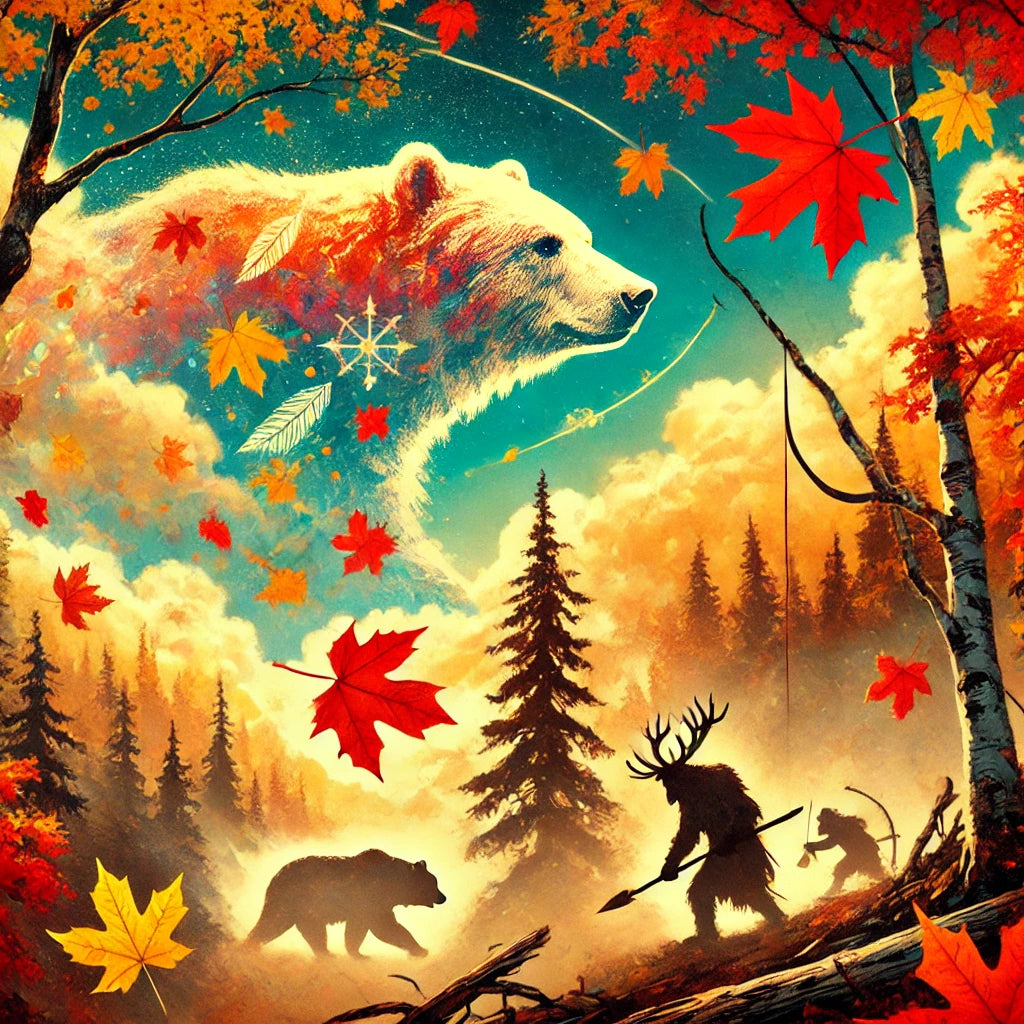
Aboriginal Legend of Autumn: The Great Bear and the Red Leaves
Share
Autumn is a season when nature changes dramatically, including the changing colors of leaves. For the Indigenous peoples of North America, these natural changes were often explained through stories deeply rooted in their spiritual traditions and connection to nature. One such legend is the Algonquin legend of the Great Sky Bear, which explains why leaves change color in the fall.
The Great Bear Hunt

In Algonquin tradition, autumn is marked by a mythical hunt that takes place in the sky. The Great Spirit, accompanied by celestial hunters, tracks down a huge bear. This Great Bear, who lives among the stars, is a powerful and majestic being. According to legend, when the bear is wounded during the hunt, its blood flows from the sky and spreads onto the trees of the Earth, dyeing the leaves a deep red. The drops of bear fat, falling on the vegetation, give the leaves shades of yellow and gold.
This story symbolizes the Algonquins' connection to the cycle of life and death, as well as the changing nature around them. The hunt of the sky bear is a reminder that, just like the seasons, everything in life is a cycle, with death and rebirth always in balance.
The Meaning of Fall Colors
The vibrant colours of the leaves in the fall are therefore not just a natural phenomenon for the Algonquin. They are a reflection of a cosmic event that connects the Earth and the heavens, an annual reminder of ancient stories of hunting and sacrifice. The red represents the spilled blood of the Great Bear, a symbol of life and death, while the yellow and gold symbolize the generosity and abundance of nature before the arrival of winter.
A lesson in respect for nature
Like many Indigenous stories, this legend teaches us to respect nature and the cycle of the seasons. It reminds us that every part of nature is interconnected, and that humans must honour these connections by living in harmony with their environment. The changing of the leaves in the fall is a sacred time, not only to admire the beauty of nature, but also to reflect on our own place in the universe.
Conclusion
The legend of the Great Bear and the Red Leaves is a beautiful illustration of how Indigenous peoples viewed the world around them. Through these stories, they conveyed not only explanations for natural phenomena, but also profound spiritual teachings. As we admire the colors of fall today, it is important to remember that these colors are more than just a visual spectacle; they are a reflection of an ancient history, rich in meaning and wisdom.
Sources and references:
1. Algonquin Legends and the Seasons, Encyclopedia of Native American Myths
2. Indigenous Tales of the Changing Seasons, Native Knowledge 360°
The Great Bear Hunt

In Algonquin tradition, autumn is marked by a mythical hunt that takes place in the sky. The Great Spirit, accompanied by celestial hunters, tracks down a huge bear. This Great Bear, who lives among the stars, is a powerful and majestic being. According to legend, when the bear is wounded during the hunt, its blood flows from the sky and spreads onto the trees of the Earth, dyeing the leaves a deep red. The drops of bear fat, falling on the vegetation, give the leaves shades of yellow and gold.
This story symbolizes the Algonquins' connection to the cycle of life and death, as well as the changing nature around them. The hunt of the sky bear is a reminder that, just like the seasons, everything in life is a cycle, with death and rebirth always in balance.
The Meaning of Fall Colors
The vibrant colours of the leaves in the fall are therefore not just a natural phenomenon for the Algonquin. They are a reflection of a cosmic event that connects the Earth and the heavens, an annual reminder of ancient stories of hunting and sacrifice. The red represents the spilled blood of the Great Bear, a symbol of life and death, while the yellow and gold symbolize the generosity and abundance of nature before the arrival of winter.
A lesson in respect for nature
Like many Indigenous stories, this legend teaches us to respect nature and the cycle of the seasons. It reminds us that every part of nature is interconnected, and that humans must honour these connections by living in harmony with their environment. The changing of the leaves in the fall is a sacred time, not only to admire the beauty of nature, but also to reflect on our own place in the universe.
Conclusion
The legend of the Great Bear and the Red Leaves is a beautiful illustration of how Indigenous peoples viewed the world around them. Through these stories, they conveyed not only explanations for natural phenomena, but also profound spiritual teachings. As we admire the colors of fall today, it is important to remember that these colors are more than just a visual spectacle; they are a reflection of an ancient history, rich in meaning and wisdom.
Sources and references:
1. Algonquin Legends and the Seasons, Encyclopedia of Native American Myths
2. Indigenous Tales of the Changing Seasons, Native Knowledge 360°














